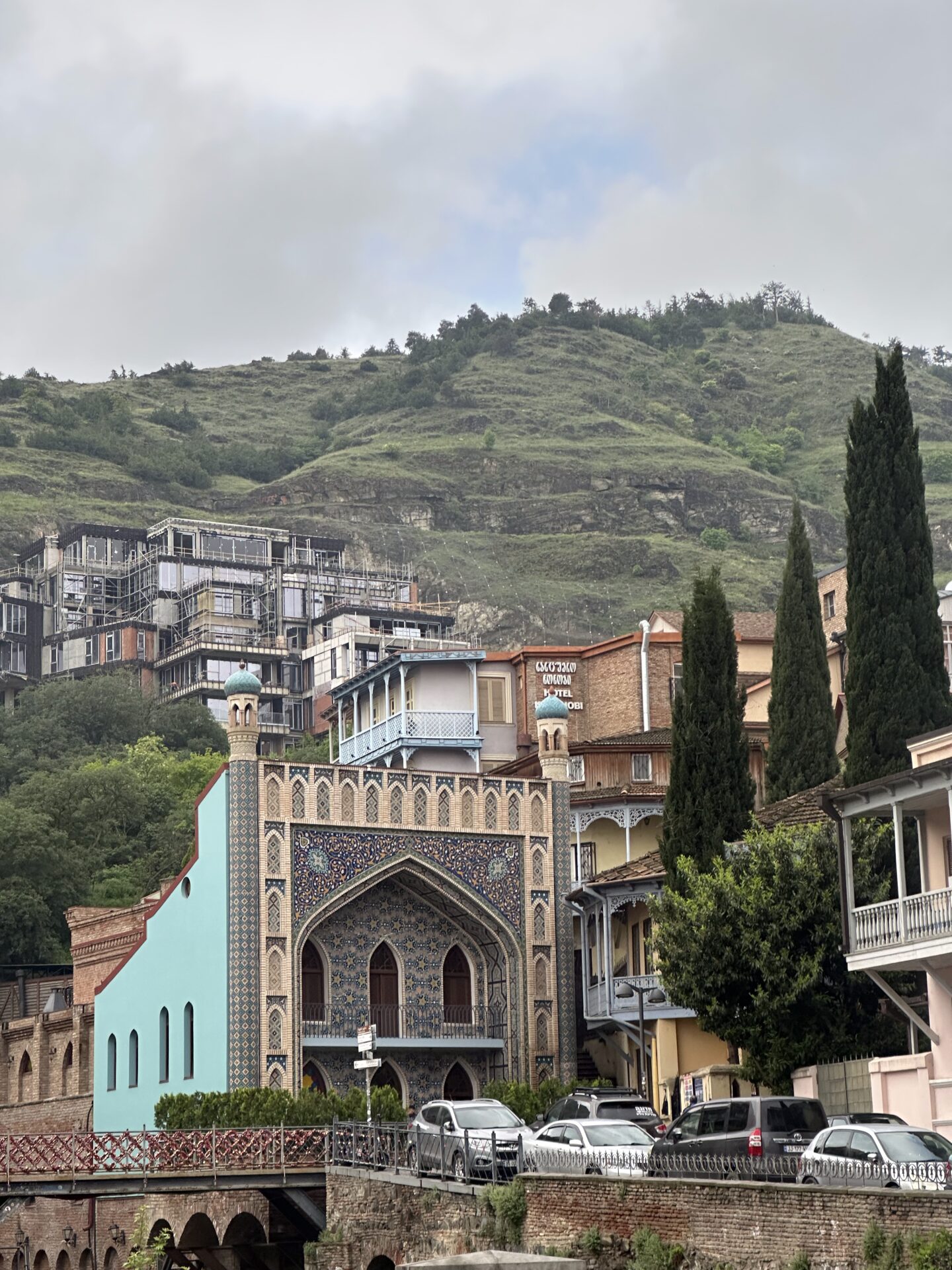I’d been itching to travel somewhere I hadn’t visited before and all it took was one Instagram Reel to convince me that Georgia was the place. It seemed to offer a beautiful capital city bursting with a complex history, hearty cheese and bread focused cuisine, cafes and restaurants in transformed buildings, and… a renowned wine region? It felt like there was an abundance of things to do in Tbilisi and I was sold.
Tbilisi is a city that will instantly capture you. The charming blend of historic buildings against modern ones, the monuments that shared moments of recent history, the rapid Kura River flowing through the city, the hidden cafes and wine bars tucked into cobblestone streets.
Tbilisi feels like a city that is continuing to reinvent itself while honouring its deep-rooted heritage, and that’s something I really loved about it. After four days exploring this fascinating city, here are some of the top things to do in Tbilisi.
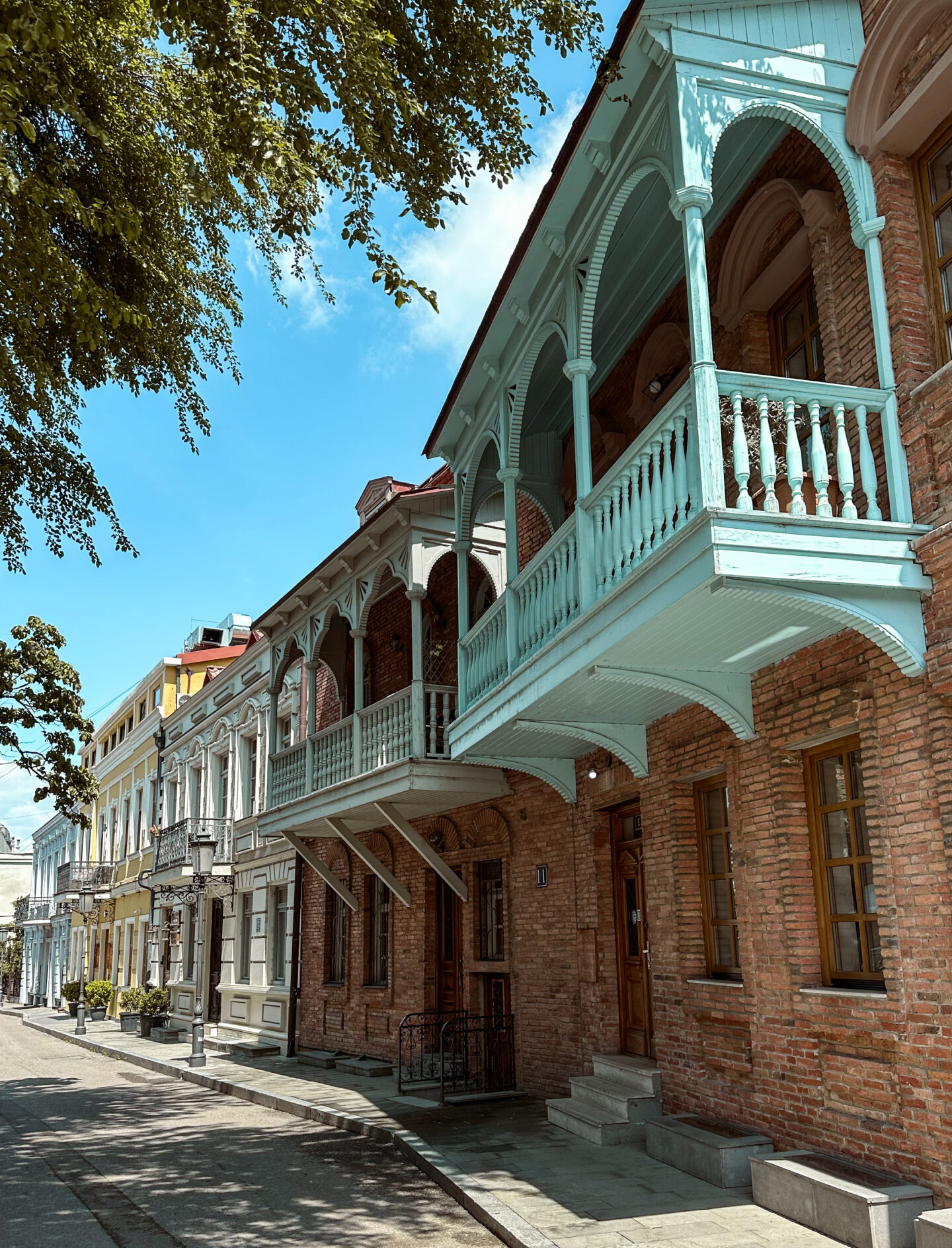
Top things to do in Tbilisi
Mtatsminda Park
Translating to Holy Mountain, Mtatsminda Park sits 300 metres above the capital city, offering spectacular views of Tbilisi. Not only is it a great place to enjoy the sunset and take in the views, but it’s actually an amusement park complete with rollercoaster, ferris wheel and water slide! It’s a really fun way to spend the afternoon/evening and I highly recommend visiting on a weekday since there will be less kids around.
There are a few ways to reach the park: funicular, cable car and bus. We decided to take the cable car to enjoy the views on the way up and even the cable car station was a sight in itself!
Cost for the cable car: 12 GEL one-way (approximately £3.29)
Cost for the funicular: 10 GEL one-way (approximately £2.74)
Cost for the local bus: 1 GEL when using a travel card or 1.50 GEL if using contactless card payments
*Prices correct at time of posting
**In addition to the cost of the above tickets, you need to pay 2 GEL for a plastic travel card. They sell these at the ticket booth for the cable car and funicular.
Mtatsminda Park Opening Hours
Mtatsminda Park is open midday until 11pm Monday-Friday and 11am-11pm on weekends.

Sulphur Baths in Abanotubani
The name Tbilisi actually originates from the Georgian word ‘tbili’, meaning ‘warm’. According to legend, King Vakhtang Gorgasali discovered the hot springs in the 5th century and was so impressed by this natural phenomenon, he decided to name the city around them.
These geothermal springs, rich in sulphur, are said to have therapeutic properties that may aid skin conditions, arthritis, and improve circulation.
After a few days of exploring the city on foot, averaging around 18,000 steps a day, a dip in the sulphur baths was just what we needed. There are two types of bath to choose from:
- Public Baths: Communal spaces separated by gender, offering an authentic experience. These cost approx. 10-30 GEL per person per hour, depending on which spa you visit.
- Private Rooms: Ranging from basic to luxurious, these rooms often include a hot sulphur pool, cold plunge, sauna, and seating areas. Private rooms are a bit more expensive, starting from 80 GEL per room per hour.
I’d highly recommend booking a private room, especially if there’s a couple of you to split the cost. Enhance your experience with a kisa scrub: a vigorous exfoliation using a coarse cloth, leaving the skin rejuvenated! This can cost around 10-20 GEL.
Sample Georgian Wine
Georgia has a wine region that really deserves more recognition. Kakheti, just one hour out of Tbilisi, is one of the main producers of Georgian wine and you can find it served in many wine bars across the city.
Georgian wine has a very unique taste thanks to its fermentation process. A typical European wine would be made in stainless steel tanks with a temperature-controlled fermentation process and usually, contains additives for stability.

Whereas, Georgian wines are made in large clay vessels buried underground called qvervi. They often use multiple grape varieties in a single wine and grapes are crushed and fermented with their skins, stems and seeds in the qvervi that help initiate natural yeasts, creating a more natural wine.
Many of their white wines are darker in colour, closer to an amber wine, due to the skins and stems being used during fermentation. Of course, this was on of my favourite things to do in Tbilisi and here are some spots to enjoy some local wine:
Wine bars in Tbilisi:
- Tsangala’s Wine Shop & Bar. 12 Ioane Shavteli St, Tbilisi 0105, Georgia
- Vinissimo Wine Bar & Shop. 3 Ioane Shavteli St, Tbilisi, Georgia
- Impulse. 4 Vertskhli Turn, Tbilisi 0108, Georgia
- Gamarjoba Wine Store. 15 Ованес Туманян, Tbilisi 0105, Georgia
- DADI Wine Bar & Shop. 4 Shalva Dadiani St, Tbilisi 0105, Georgia
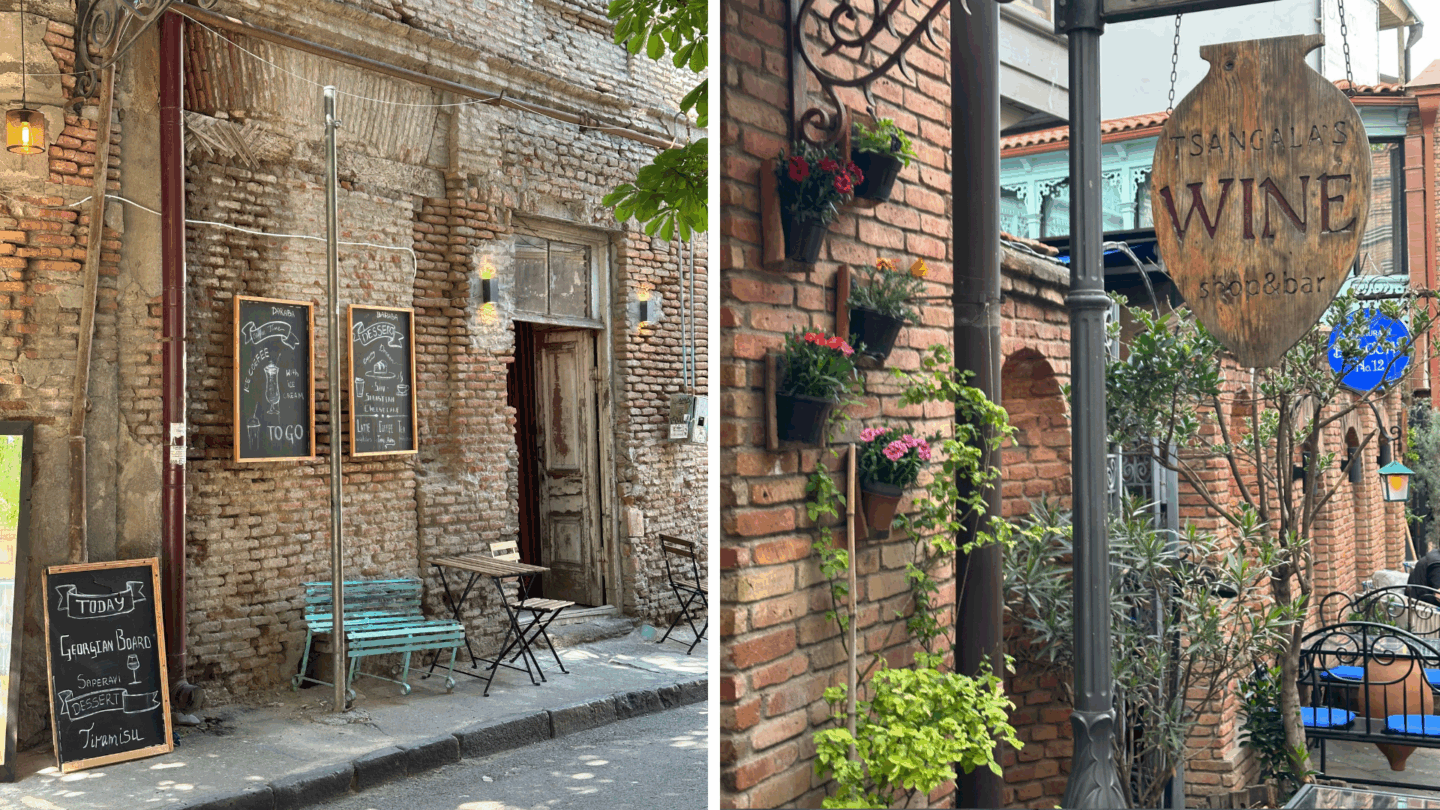
Cable car up to Narikala Fortress
Towering above the city, Narikala Fortress is one of Tbilisi’s oldest and most significant landmarks. Once a Persian citadel dating back to the 4th century before an explosion of Russian military weapons destroyed it in the 1800s. Now, just the remains of the walls are intact. Within the fortress, you can visit The Church of St. Nicholas, which was rebuilt in the 1990s and features beautiful artwork illustrating scenes from the bible and the history of Georgia.

Beyond the fortress you can also see the statue of Kartlis Deda – Mother Georgia. You can see her overlooking the city, wielding a sword in one hand and a cup of wine in the other. Up close, her grandeur is even more spectacular and depicts the character of Georgian women – the wine represents a warm welcome to guests whilst the sword warns of strength against enemies.
You can take the cable car up from Rike Park, or alternatively you can walk up from Meidan. The path is steep but well-paved so it’s not super challenging.
Cost for the Narikala cable car: 2.5 GEL one-way plus 2 GEL for the travel card
The views from the top are pretty impressive. With sweeping views across the city, you can see everything from the grand Holy Trinity Cathedral of Tbilisi and Metekhi Virgin Mary Assumption Church to the Kura River and Peace Bridge. I’d recommend visiting about an hour before sunset. Although you don’t necessarily get sunset views, the soft colours settle across the city and once the sun goes down, the city lights dazzle with life.
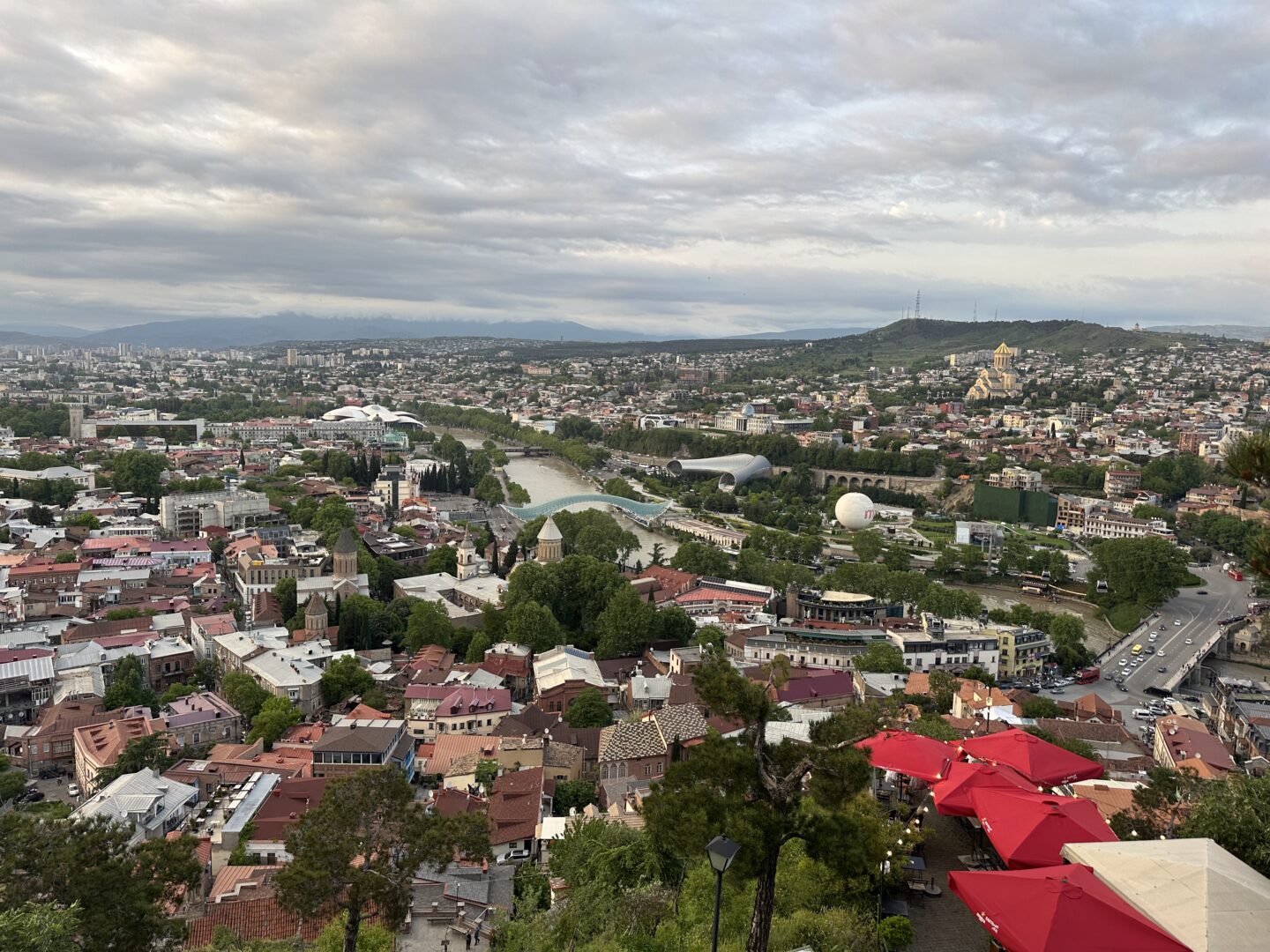
Peace Bridge
Straddling the Mtkvari River, the Peace Bridge is one of Tbilisi’s most iconic landmarks. Designed by Italian architect Michele De Lucchi and opened in 2010, the bridge connects the historic district of Old Tbilisi with the modern Rike Park, serving as both a literal and symbolic link between Georgia’s past and future.
Constructed from glass and steel, its curvaceous, futuristic design stands in contrast to the ancient buildings that surround it. Apparently, it was not much welcomed by locals, due to its highly contrasting design, however, walking across it provided really beautiful views and it was pretty cool to see from the top of Narikala Fortress too.
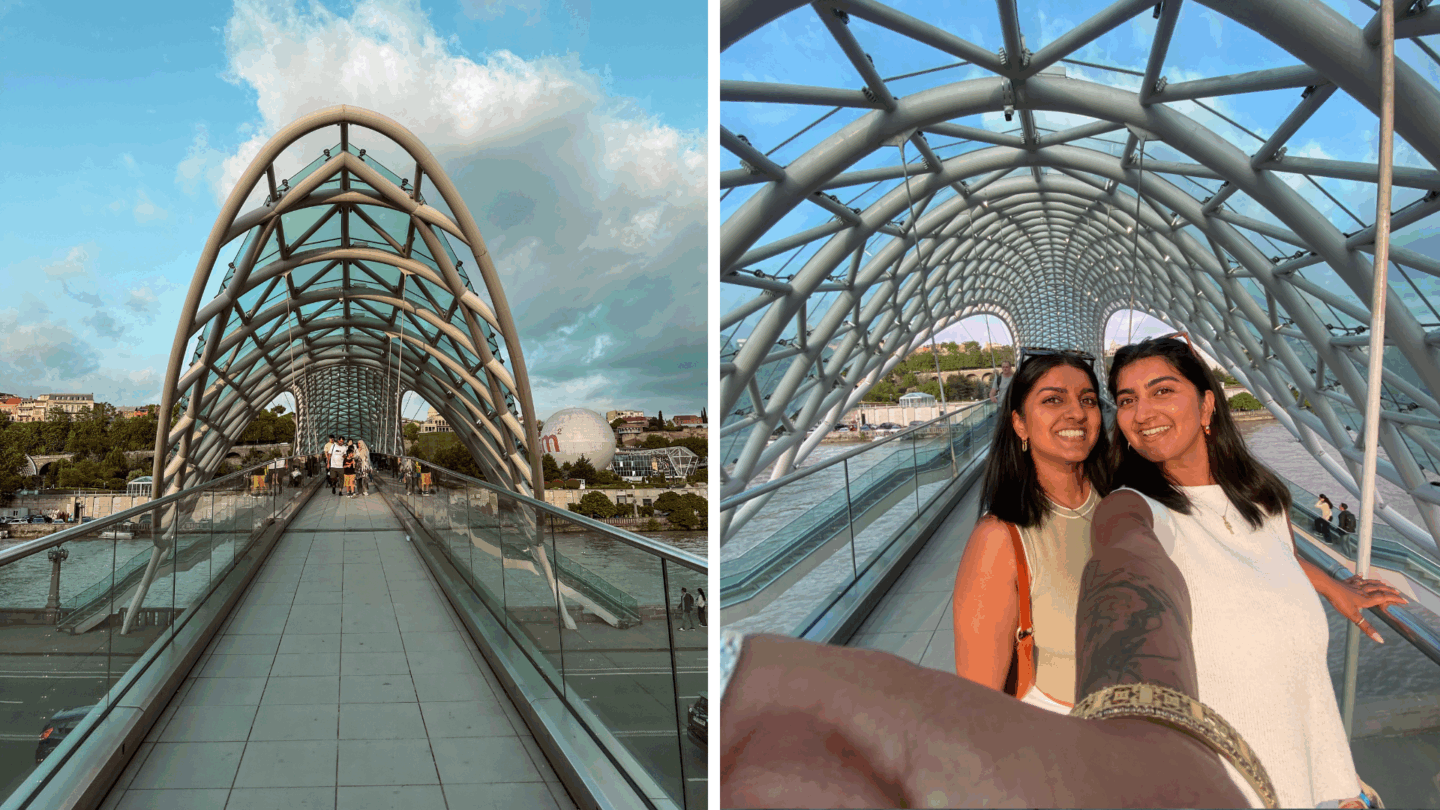
Freedom Square
Freedom Square has seen it all: imperial conquests, Soviet rule, independence movements, and modern-day protests. Originally named after Russian General Paskevich in the 19th century, it was later dubbed Lenin Square during Soviet times. But in 1991, as Georgia reclaimed its independence, the square was fittingly renamed Freedom Square.
In the centre stands the Monument of St. George, a towering golden statue of Georgia’s patron saint slaying a dragon. The monument rises approximately over 114 feet high and is easily spotted from various points in the city.
Surrounded by neoclassical buildings, bustling cafes, and shops, Freedom Square is more than just a historical site. You can find some fantastic food nearby – try Baba’s Bakery for fresh pastries and coffee or Pasanauri for hearty, authentic dishes like osteri (beef stew) and kinkali (Georgian dumplings).
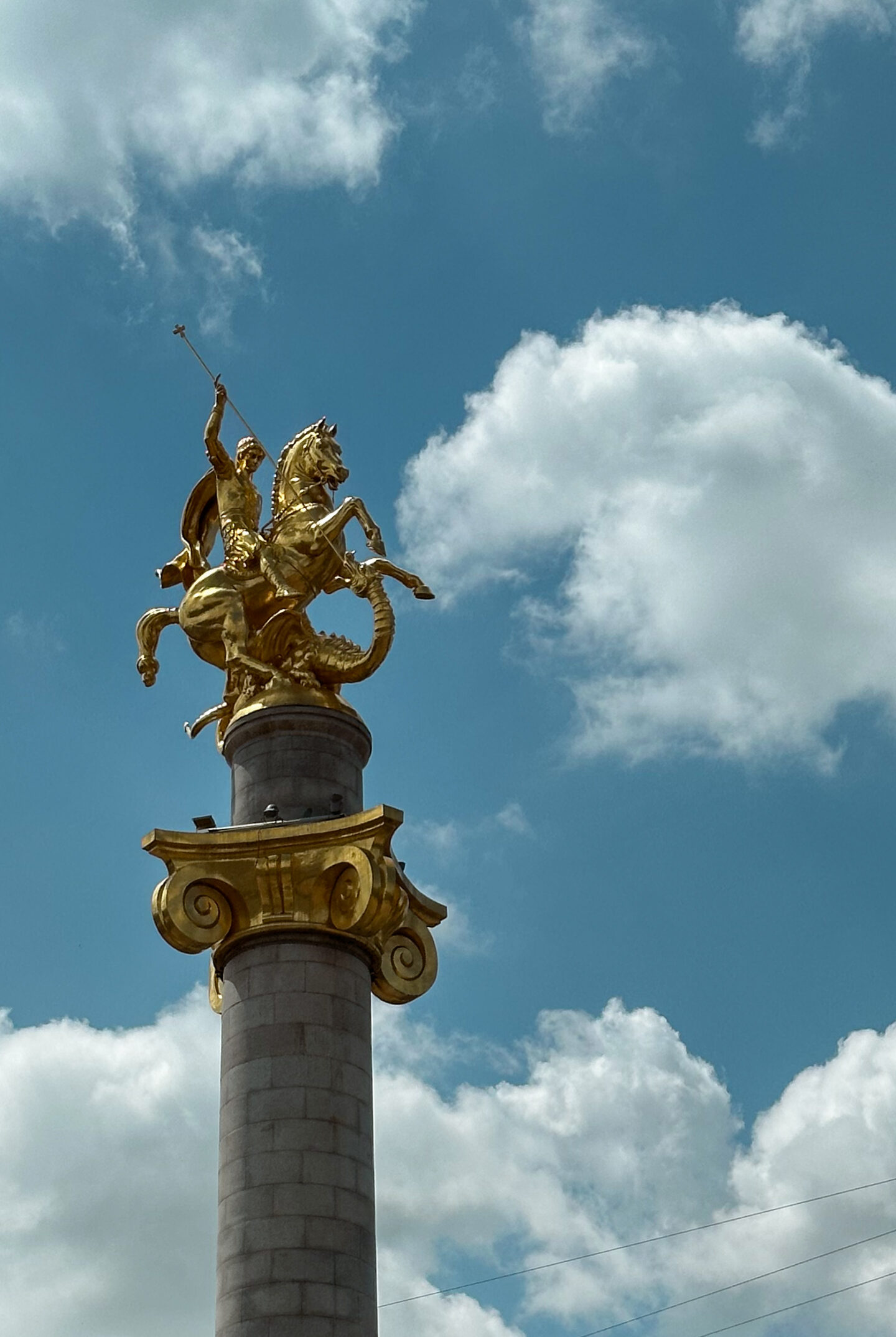
Take a guided walking tour
One of my favourite ways to explore a new city is to book myself onto a walking tour. The guides are usually locals who’ve spent their life in the city and have so much knowledge and passion to share. It’s a great way to gain a deeper understanding of the history and culture of the city, which Tbilisi is full of! Get your walking shoes on because they tend to be anywhere between 2-3 hours! Tbilisi is a very walkable city and with so much to see, a walking tour is the best way to pick your guide’s brain for their top local recommendations too!
Find a guided walking tour below:
Bazari Orbeliani
Bazari Orbeliani is a new-ish (opened in 2021) vibrant destination offering a diverse range of food options. It’s pretty trendy inside, with small boutiques offering artisanal food products like fresh spices and tea on the ground floor. There were also a couple of vintage clothing pop ups and jewellery stalls.

On the first floor, you’ll find a fantastic food court. From Greek gyros and Turkish shawarma to Korean bibimbap and Thai curry, there is an incredible selection. Of course, you can also get your hands on some authentic Georgian fare like khinkali and khachapuri but one of my highlight meals was at the Uzbek spot called Shahruza. The Tashkent pilaf (beef rice), dolma (meat and rice stuffed vine leaves), samsa (similar to a samosa) and manti (dumplings) were all bursting with flavour!
On weekends, they had a DJ and the energy was buzzing. On a sunny day, make sure to enjoy a drink on their outdoor terrace! It’s a short walk away from Freedom Square and makes for a great spot to enjoy hearty meals.

Dry Bridge Market
The Dry Bridge Market is a treasure trove of antique goods and handcrafted items, perfect for one-of-a-kind souvenirs. This open-air flea market is a place to find old coins, vintage cameras, intricately designed textiles, paintings and other rare gems that tell the stories of Georgian history. The market started post-Soviet communism where locals would go to sell their possessions for extra cash.

The Dry Bridge Market runs every day in the centre of the city, between 10:00 and 17:00, though it is all outdoors so if there is heavy rain or snow, vendors may choose to stay home. Though weekends will be busier, there are more vendors there so you may want to visit on a Saturday or Sunday.
Set on the Dry Bridge, which once used to cross the gushing Mtkvari River, it is now dry after an embankment was built to protect Old Tbilisi from frequent flooding. The river’s course was altered and instead of water, the bridge spans a dry street… and the name stuck.
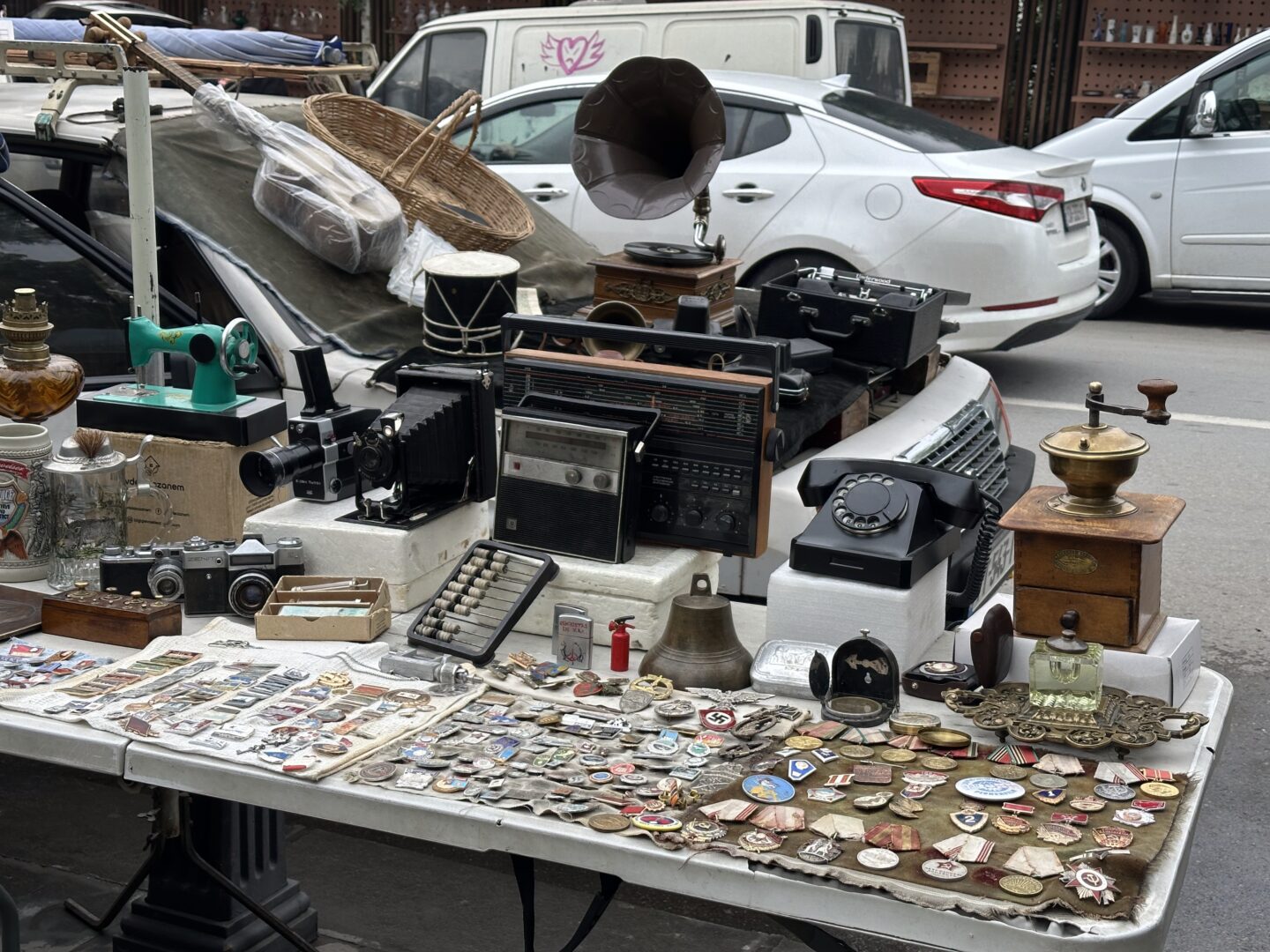
Fabrika Hostel Drinks
Once a Soviet sewing factory, Fabrika has been transformed into a vibrant urban hub for food, art, culture and socialising. It’s a hotspot for students, visitors or groups looking for a vibey place to enjoy a drink. The central courtyard is the highlight, with a selection of wine bars, pizza shops, bars and cafes on one side with independent boutiques on the other offering vinyl records, ceramics, plants, cameras and more.
It was great sitting here for a few hours, bar hopping and soaking in the atmosphere. We first stopped at Popolo for a local Georgian beer before making our way to Camora Barber Shop (which actually is a barbershop) for cocktails and then to Tone for a glass of amber wine. Tone was my favourite, with local wine, cheese and bread baked in a tone oven on offer.
Not only is it a social space but Fabrika is a hostel with dorms and private rooms as well as a perfect spot for coworking.
A bed in a dorm room starts from approx £6 per person
A private double room starts from approx. £33 per room.
Located in the old, historical district on the left bank of the Mtkvari River, the surrounding area has been revitalised in recent years with plenty of unique boutiques, cosy cafes and vintage stores to explore nearby. Fabrika’s blend of old and new, historic and modern perfectly embodies what Tbilisi is all about.
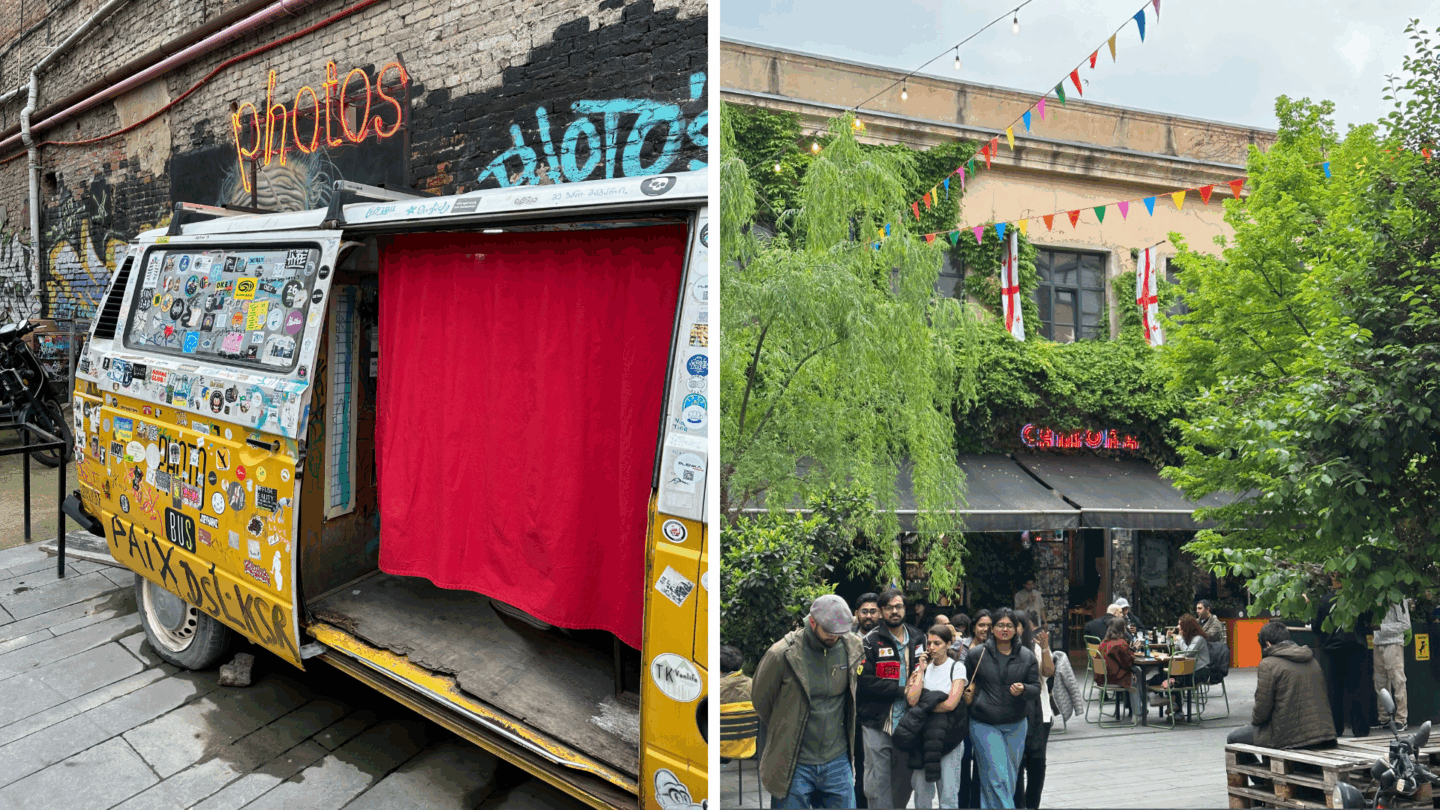
Meidan Bazaar
Set in a tunnel underground, Meidan Bazaar is a great place to pick up trinkets and souvenirs for home. Filled with an array of local wine, churchkhela, honey, art, jewellery and antiques.
Apparently, the square above used to be an ancient bazaar district, where merchants came to trade from many neighbouring countries. However, none of these stalls remain. Instead the underground marketplace that stands today is an ode to the bustling bazaar it once was.
Just above ground, you’ll be near Rike Park, the Metekhi Bridge and Church and the Narikala Fortress just up above.

Day trip to the mountains in Kazbegi
There are a few day trips to take from Tbilisi. For a trip to the wine regions, visit Kakheti, for a day exploring canyons and caves, head to West Georgia, or for a trip to the mountains, Kazbegi is the trip for you. This is the one I chose and it was such an interesting insight into some of the history of Georgia.
Our stops included Ananuri Fortress, a medieval castle complex strategically located on the Georgian Military Road. Featuring 3 churches on site, it was a very interesting stop to see such an important defensive point in historic battles.

We also travelled along the Silk Road, with the route running through the mountains and starting all the way in Asia, so we overtook a lot of trucks! We then stopped at The Gudauri Viewpoint, or more precisely, the Russia-Georgia Friendship Monument. The monument, built in 1983 marked a significant alliance between the Russian Empire and the Kingdom of Georgia. The views are meant to be incredible up here but heavy sleet started to fall when we arrived so we didn’t get a chance to see!
Finally, we travelled further into the mountains (and very close to the Russian border) to the Gergeti Trinity Church, located in Kazbegi (formerly, Stepantsminda).
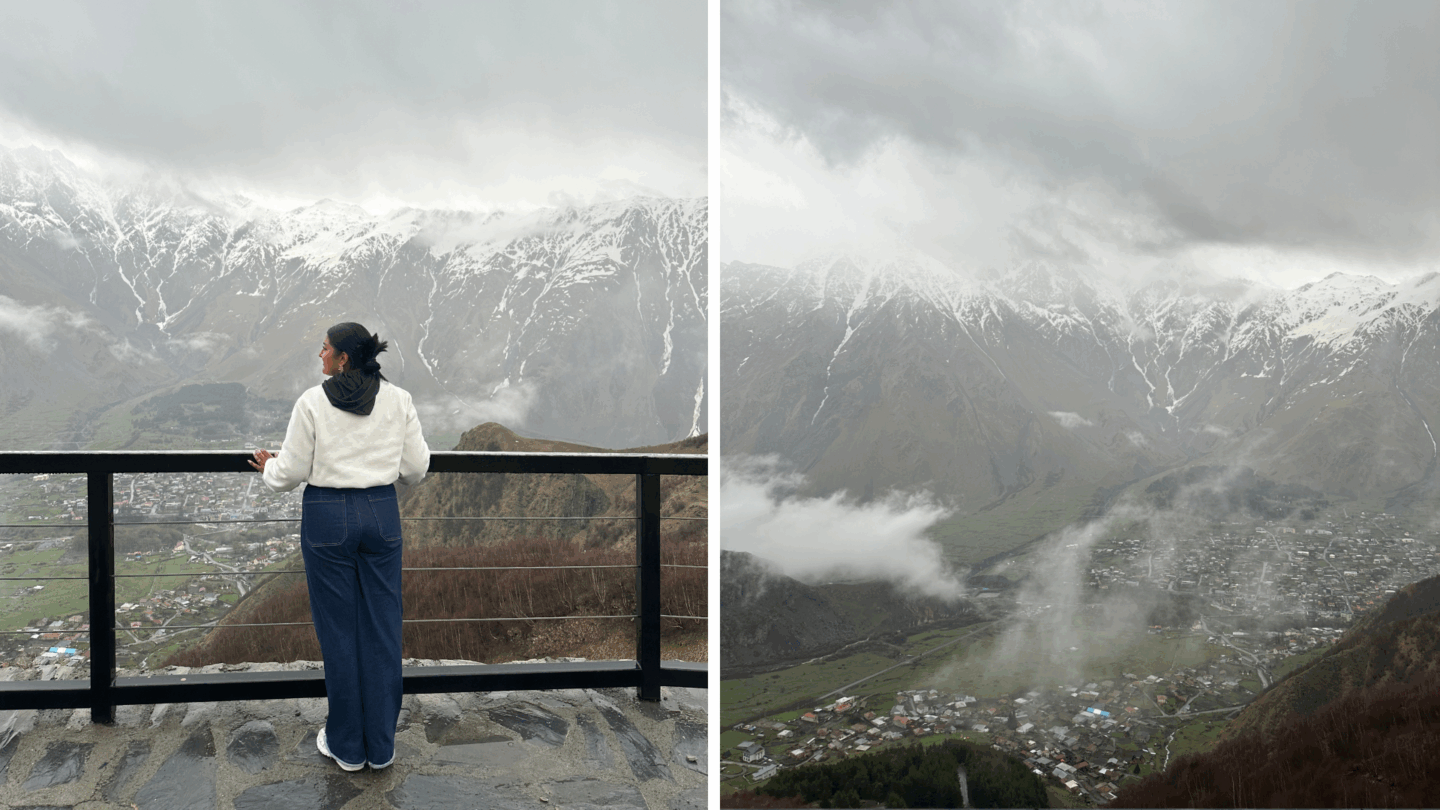
Perched dramatically on a hilltop at 2,170 meters above sea level, Gergeti Trinity Church is one of the most breathtaking and iconic landmarks in Georgia. From the top, the views of the Caucasus Mountains feel almost surreal.
Interested in this day tour? Check it out below:
If you have more time, I’d highly recommend heading outwards of Tbilisi and visiting Kakheti and Signagi, the wine region in Georgia. I had the best few days relaxing at a horse ranch in Signagi, riding through the beautiful valleys and tasting plenty of local wine. You can do a day tour to Kakheti for wine tasting if you’re short on time but I loved my few days unwinding here. Questions about Georgia? Feel free to drop a comment or get in touch!
